Buran (spacecraft)
Buran (Russian: Буран, IPA: [bʊˈran], meaning "Snowstorm" or "Blizzard"; GRAU index serial number: 11F35 1K, construction number: 1.01) was the first spaceplane to be produced as part of the Soviet/Russian Buran program. Besides describing the first operational Soviet/Russian shuttle orbiter, "Buran" was also the designation for the entire Soviet/Russian spaceplane project and its orbiters, which were known as "Buran-class orbiters".
| Буран | |
|---|---|
_1.JPEG.webp) Buran on An-225 at the 1989 Paris Air Show | |
| Type | Buran-class orbiter |
| Construction number | 1.01 |
| Country | Soviet Union |
| Named after | Russian for "Snowstorm"[1] or "Blizzard" |
| Status | Destroyed 12 May 2002[2] |
| First flight | 15 November 1988[1] |
| No. of missions | 1[1] |
| Crew members | 0[1] |
| No. of orbits | 2[1] |
Buran completed one uncrewed spaceflight in 1988, and was destroyed in the 2002 collapse of its storage hangar.[3] The Buran-class orbiters used the expendable Energia rocket, a class of super heavy-lift launch vehicle.
It is named after the Asian wind.
Construction
The construction of the Buran spacecraft began in 1980, and by 1984 the first full-scale orbiter was rolled out. Over 1000 companies all over the Soviet Union were involved in construction and development. The Buran spacecraft was made to be launched on the Soviet Union's super-heavy lift vehicle, Energia. The Buran program ended in 1993.[4]
| Date | Milestone[5][6] |
|---|---|
| 1980 | Assembly started |
| August 1983 | Fuselage delivery to NPO Energia |
| March 1984 | Start of comprehensive electrical testing |
| December 1984 | Delivery to Baikonur |
| April 1986 | Start of final assembly |
| 15 November 1987 | Final assembly completed |
| 15 November 1987 – 15 February 1988 | Testing in MIK OK |
| 19 May – 10 June 1988 | Test rollout |
| 15 November 1988 | Orbital flight (1K1) |
Technical description

The Buran orbiter is built around a "glider", which is its main structural component, since all other components such as wings and the crew cabin are attached to it. The components necessary for flight make up approx. 20% of the weight of the orbiter, while another 11% of weight is added by payload systems and removable parts. The wings of the Buran orbiter contain elevators whose position can be changed from +35° to −20°.[7]
Exterior
Similarly to US space shuttle orbiters, Buran orbiters have their exterior covered in 38,600 heat shielding tiles designed to withstand 100 reentries,[8][9] which themselves were very similar to the ones in the space shuttle,[10] however, the carbon-carbon Buran heat tiles have an antioxidant molybdenum disilicide coating. The black coating in the carbon-carbon heat tiles helps dissipate heat, and, similarly to the heat tiles used in the space shuttle, Buran heat tiles are glued to the orbiter, and the bottom of the heat tiles are left uncoated to equalize the pressure in the tile with that of its surroundings, preventing additional mechanical loads. The gaps between tiles are deliberate to allow for thermal expansion. The gaps were filled with quartz fiber, rope, alkaline elements, inserts and brush seals, and the carbon-carbon heat tiles were also waterproofed.[8][11]
The Buran and space shuttle orbiters are exposed to similar temperatures, and both have similar levels of insulation. Buran has a different carbon-carbon heat tile layout in its underside, in which all gaps between heat tiles are parallel or perpendicular to the direction of airflow through the orbiter's underside, reducing heat in between heat tiles and in the boundary layer between the heat tiles and surrounding air, while helping maintain a laminar airflow through the orbiter.[9][8]
Crew cabin
The cabin is an all-metal, welded, pressurised compartment housing the crew's workplaces, control and life support systems. It has three decks. The Command Module on the upper deck is the workspace for the crew and serves to accommodate the commander, pilot, engineer and mission specialist's seats, as well as the RMS operator's workplace. The middeck houses life support and auxiliary equipment, and up to six crewmembers could be seated there during launch and reentry. The lower deck houses the power systems.[12] The cockpit is similar in layout to that of the space shuttle, with three cathode-ray tube displays.[13]
Automatic landing system
The automatic landing system is capable of performing a fully automatic descent, approach and landing from any point located in the "admissible starting conditions area" at 100 kilometres (62 mi) altitude, controlling the orbiter's flight during the descent. Covering 8,000 kilometres (4,300 nmi) during the approach and eventually slowing down from 28,000 kilometres per hour (15,000 kn) to zero.[14]
The first Buran flight was notable for the automatic landing system electing to perform an unlikely (estimated 3% probability) manoeuvre at the 20 kilometres (66,000 ft) key point, which was needed to extend the glide distance and bleed excessive energy. The standard approach was from the south and consisted of two left turns onto the final approach course. Instead, it performed additional turns in both directions and overflew the field to its northern side, before making a right turn back onto the final course. The landing system elected to perform the manoeuvre as the orbiter's energy didn't decrease enough due to strong-gusty winds in the area, measured at 15 metres per second (29 kn) and gusting up to 20 metres per second (39 kn) at ground level.[15]
Docking system
The docking module (Стыковочный модуль) is mounted into the forward part of the payload bay. It is a spherical compartment with a diameter of 2.67 m (8.8 ft), with a cylindrical tunnel leading to the androgynous peripheral docking unit (APAS-89). Unlike the U.S. Space Shuttle, the docking compartment for Buran features an extendable tunnel to increase clearance between orbiter and station. Another hatch, facing into the payload bay, was to support extravehicular activity from the orbiter.[16]
Remote manipulator
The Onboard Manipulator System (Система Бортовых Манипуляторов), similar to the Space Shuttle's RMS, was developed at the Central Research and Development Institute for Robotics and Technical Cybernetics to support operations with payload. It could be operated both in manual and automatic modes. Buran-class orbiter could carry, depending on the mission, one or two manipulator arms.[16][17][18]
Laboratory modules
To expand Buran's capabilities, pressurised modules similar to ESA's Spacelab were designed based on the 37K design. These modules had to be both compartments to conduct experiments and logistics volume, could be mounted either in the payload bay and connected to the crew cabin via tunnel or be temporarily docked to Mir's Kristall side docking port. On Buran's maiden flight, the Accessory Unit (Блок Дополнительных Приборов) 37KB No.37070 was installed into the orbiter's payload bay. It carried recording equipment and accumulators providing power to onboard systems as the regular fuel cells based power system were not ready at the time. The second unit, 37KB No.37071 was built in 1987. It was planned to build a third unit, 37KB No.37072, but this never happened because of programme cancellation.[19]
Propulsion
Orbital maneuvering is provided by the Joint Propulsion System (Объединенная двигательная установка).[20]
Operational history

Orbital flight
The only orbital launch of a Buran-class orbiter, 1K1 (first orbiter, first flight[21]) occurred at 03:00:02 UTC on 15 November 1988 from Baikonur Cosmodrome launch pad 110/37.[3][22] Buran was lifted into space, on an uncrewed mission, by the specially designed Energia rocket. The automated launch sequence performed as specified, and the Energia rocket lifted the vehicle into a temporary orbit before the orbiter separated as programmed. After boosting itself to a higher orbit and completing two orbits around the Earth, the ODU (Russian: объединённая двигательная установка, сombined propulsion system) engines fired automatically to begin the descent into the atmosphere, return to the launch site, and horizontal landing on a runway.[23]
After making an automated approach to Site 251,[3] Buran touched down under its own control at 06:24:42 UTC and came to a stop at 06:25:24,[24] 206 minutes after launch.[25] Despite a lateral wind speed of 61.2 kilometres per hour (38.0 mph), Buran landed only 3 metres (9.8 ft) laterally and 10 metres (33 ft) longitudinally from the target mark.[25][26] It was the first spaceplane to perform an uncrewed flight, including landing in fully automatic mode.[27] It was later found that Buran had lost only eight of its 38,000 thermal tiles over the course of its flight.[26]
Specifications
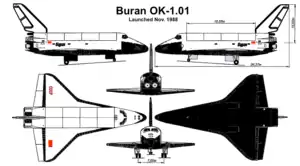
The mass of Buran is quoted as 62 tons,[28] with a maximum payload of 30 tons, for a total lift-off weight of 105 tons.[4]
Mass breakdown[3]
- Total mass of structure and landing systems: 42,000 kg (93,000 lb)
- Mass of functional systems and propulsion: 33,000 kg (73,000 lb)
- Maximum payload: 30,000 kg (66,000 lb)
- Maximum liftoff weight: 105,000 kg (231,000 lb)
- Length: 36.37 m (119.3 ft)
- Wingspan: 23.92 m (78.5 ft)
- Height on gear: 16.35 m (53.6 ft)
- Payload bay length: 18.55 m (60.9 ft)
- Payload bay diameter: 4.65 m (15.3 ft)
- Wing chine sweep: 78 degrees
- Wing sweep: 45 degrees
Propulsion[4]
- Total orbital manoeuvring engine thrust: 17,600 kgf (173,000 N; 39,000 lbf)
- Orbital manoeuvring engine specific impulse: 362 seconds (3.55 km/s)
- Total manoeuvring impulse: unknown
- Total RCS thrust: 14,866 kgf (145,790 N; 32,770 lbf)
- Average RCS specific impulse: 275–295 seconds (2.70–2.89 km/s)
- Normal maximum propellant load: 14,500 kg (32,000 lb)
Unlike the US Space Shuttle, which was propelled by a combination of solid boosters and the orbiter's own liquid-propellant engines fuelled from a large tank, the Soviet/Russian launch system used thrust from each booster's RD-170 liquid oxygen/kerosene engine (each with 4 nozzles), developed by Valentin Glushko, and another four RD-0120 liquid oxygen/liquid hydrogen engines attached to the central block.[28]
List of vehicles
Five orbiters were planned to be built (designated 1K-5K, K stands for Корабль, 'craft, flying article'), and hull numbering starts with 1 or 2 (e.g. 1.01), two originally ordered in 1970s and three ("second series") additionally ordered in 1983. For research and testing purposes, several test articles produced, designated 1M-8M (M stands for Макет, 'mock-up'), hull numbering starts with 0 (e.g. 0.02). The programme prefix OK stands for Орбитальный Корабль, 'Orbital Vehicle' and carries the GRAU index number 11F35.
By 1991 two operational vehicles were delivered to Baikonur, three others were under construction at Tushino.
Most of the geo-locations below show the orbiter bodies on the ground; in some cases Google Earth's History facility is required to see the orbiter within the dates specified.[29][30]
| Name | Function | Location | Image | Geo-location | Approximate dates | Notes |
|---|---|---|---|---|---|---|
| Flight orbiters | ||||||
| Buran 1K 1.01 |
First flight article, first spaceplane series | Baikonur Cosmodrome Site 110/37 (L) at Baikonur | 1988 1989 1989 |
45.96486°N 63.30496°E Spaceplane not visible; no available satellite photos | 15 November 1988 | Built in 1986, only flightworthy orbiter. Launched on an uncrewed, remote controlled flight; two orbits and landing (with heavy crosswinds and a self-initiated approach direction change) at Yubileiniy (Jubilee) Airport, Baikonur. |
| MIK building, Baikonur Cosmodrome, Kazakhstan | 2002 | 45.92750°N 63.29761°E Spaceplane not visible; shadows | 1988 to 2002 | Housed in MIK building in area 112, Baikonur with an Energia booster mockup and other Energia hardware, destroyed in a roof collapse on 12 May 2002, which killed eight workers. | ||
| Ptichka 2K 1.02 |
Second flight article, first series, 95–97% complete | MIK building, Baikonur Cosmodrome, Kazakhstan | 45.92836°N 63.29809°E Shuttle not visible, in building | 1988 to 1995 | Built in 1988, housed adjacent to Buran. | |
| MZK building 80, area 112a, Baikonur | 2015 | 45.94046°N 63.31841°E Spaceplane not visible; in building | 1995 to present | Moved to the MZK in August 1995.[31] Reportedly property of Russian-Kazakh company Aelita since 2005.[32] | ||
| 3K 2.01 |
First flight article, second series, 30–50% complete | Inside Tushino Plant, Moscow, Russia | 1991 to 2006 | Built 1991 | ||
| Car park on Kimki Reservoir, near plant | 2007–2011 | 55.84136°N 37.46625°E; use history | 2006 to 2011 | Moved outdoors | ||
| Zhukovsky Airport, near Moscow, Russia |  2011 2011 |
on 15 August 2011 55.57125°N 38.143°E; use history | 2011 to present | An exhibit in the MAKS-2011 and later air shows. Zhukovsky International Airport is the site of the Gromov Flight Research Institute, and has become a large outdoor flight museum. Other sightings: on 15 March 2012: 55.56565°N 38.14491°E, on 31 July 2012 and 8 May 2013 55.56309°N 38.14714°E, on 4 June and 29 July 2014 55.55179°N 38.14463°E, on 11 September 2016 through 2020 55.57125°N 38.143°E. As of December, 2021, it has been reportedly bought by Vadim Zadorozhny, in order to be restored and displayed in a museum near Moscow [33] | ||
| 4K 2.02 |
Second flight article, second series, 10–20% complete | Tushino plant, Moscow, Russia | 1991–present | Build started 1991, some pieces of 2.02, like heat tiles, have found their way onto eBay.[34] | ||
| 5K 2.03 |
Third flight article, second series, very small amount assembled | Scattered | 1988 to present | All parts have been scattered and are unidentifiable. | ||
| Test articles | ||||||
| OK-M OK-ML-1 BTS-001 1M 0.01 |
Airframe and shake test bed article | Outdoor pad, area 112, Baikonur Cosmodrome, Kazakhstan | 45.91963°N 63.30996°E; use history | 1988 to January 2007 | Built in 1982, deteriorated considerably outdoors on pad | |
| Gagarin Museum, Baikonur Cosmodrome, Kazakhstan | 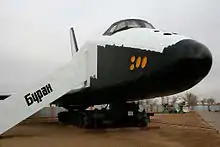 2007 2007 |
45.90963°N 63.31789°E | January 2007 to present | Refurbished in 2007, now on outdoor display | ||
| OK-GLI OK-ML-2 BTS-002 2M 0.02 |
Atmospheric test article, two extra jet engines in rear to facilitate take-off | Ramenskoye Airport, Moscow | 55.5631°N 38.14716°E; no history available this far back | 1999 | Built in 1984, used in 25 test flights. On display at MAKS-1999, Russia's most prestigious airshow. | |
| Pyrmont Island, Sydney harbor, Australia | 2000.jpg.webp) 2002 2002 |
33.86392°S 151.19662°E; use history to see shelter, shuttle not visible | February 2000 to September 2000; afterwards stored on the site until about Oct 2002 | Sold and sent in February 2000 to the Sydney, Australia 2000 Olympic Games. Displayed inside a light structure, stored outdoors there afterwards. | ||
| Manama harbor, Bahrain | 26.19826°N 50.60243°E; use history | July 2004 to 2007 | Stored outdoors in Bahrain while the ownership of the spaceplane was legally contested. | |||
| Technik Museum, Speyer, Germany[35] |  2008 2008 |
49.31185°N 8.44628°E; shuttle not visible, in building | 2008 to present | Purchased from Roscosmos State Corporation when it won the legal battle, displayed indoors. | ||
| OK-KS 3M 0.03 |
Electrical test article | Checkout and Test Building (KIS), RKK Energia Plant, Korolev, Russia | 55.92132°N 37.79929°E; not visible, in building. This location shows a half-scale memorial of Energia and the Buran, perhaps meant to be replaced. | 2006 to 15 October 2012 | Built in 1982, stored inside | |
| Grounds of the RKK Energia plant | 55.91685°N 37.79937°E | 15 October 2012 to June 2017 | Stored outside by 15 October 2012, intended to be placed on permanent display.[36] | |||
| Sirius Science Center, Sochi, Krasnodar Krai, Russia | 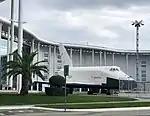 2018 2018 |
43.414442°N 39.949115°E | June 2017 to current | On permanent outdoor display at the Sirius Science Center in Sochi, Russia.[37][38] | ||
| OK-MT 4M 0.04 |
Engineering mockup | MZK building, Baikonur Cosmodrome, Kazakhstan | 2014 | 45.94046°N 63.31841°E; vehicle not visible, in building | 1988 to present | Built in 1983 |
| 5M 0.05 |
Environmental test parts from forward fuselage | Unknown | 1988 to present | Destroyed, parts used for OK-TVA.[39] | ||
| OK-TVI 6M 0.06 |
Environmental test article | NIIKhimMash rocket test area, near Moscow, Russia | 1988 to present | |||
| OK-TVA 7M 0.15 |
Structural test article | Gorky Park, Moscow, Russia | 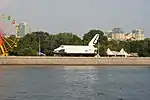 2010 2010 |
55.72876°N 37.59688°E; use history | 1995 to July 2014 | Served as an attraction, a small restaurant, and bicycle storage, as part of the now-defunct amusement park at that site. |
| Outside Pavilion 20 about 250 meters south of the Vostok rocket, VDNKh/VVT (All-Russia Exhibition Center) |  2014 2014 |
55.83219°N 37.62291°E; use history | July 2014 to present | Moved to VDNKh on 5 July 2014, assembled by 21 July.[40][41] The shuttle acquisition is part of the VDNKh refurbishment. | ||
| 8M 0.08 |
Components used for static thermal and vacuum tests | Outdoor display at Clinical Hospital No. 83 FMBA on Orekhovy Boulevard in Moscow | 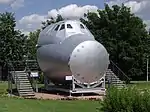 2012 2012 |
55.618°N 37.76448°E | from 24 April 2011 to present | |
| Unnamed | Wooden wind tunnel model, 1/3 scale | Ramenskoye Airport, near Moscow, Russia, photographed in 2013 | .jpg.webp) 2013[42] 2013[42] |
up to 2013 | Has been destroyed in or after 2013. Photographed at Zhukovsky International Airport by Aleksander Makin. | |
Related test vehicles and models
| Name | Function | Image | Construction date | Current status[43] |
|---|---|---|---|---|
| BOR-4 | Sub-scale model of the Spiral space plane | 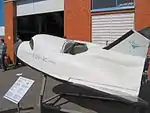 | 1982–1984 | 1:2 scale model of Spiral space plane. 5 launches. NPO Molniya, Moscow. |
| BOR-5 ("Kosmos") | Suborbital test of 1/8 scale model of Buran | .jpg.webp) | 1983–1988 | 5 launches, none were reflown but at least 4 were recovered. NPO Molniya, Moscow. |
| Wind tunnel models | Scales from 1:3 to 1:550 | 85 models built; see unnamed test article in table above. | ||
| Gas dynamics models | Scales from 1:15 to 1:2700 |
See also
- MAKS (spacecraft) – Soviet air-launched spaceplane concept
- Mikoyan-Gurevich MiG-105 – Soviet spaceplane test program
- OK-GLI – Buran Analog BST-02 test vehicle
- Space Shuttle program – American spaceplane program
- Tupolev OOS – Soviet air-launched spaceplane concept
References
- "Buran". NASA. 12 November 1997. Archived from the original on 4 August 2006. Retrieved 15 August 2006.
- "Eight feared dead in Baikonur hangar collapse". Spaceflight Now. 16 May 2002.
- Zak, Anatoly (25 December 2018). "Buran reusable orbiter". Russian Space Web. Retrieved 28 June 2019.
- Wade, Mark. "Buran". Encyclopedia Astronautics. Archived from the original on 20 August 2016. Retrieved 28 June 2019.
- ""Reusable space system "Energia – Buran" (in russian)". Retrieved 12 April 2020.
- "ground preparation". Retrieved 12 April 2020.
- "Конструкция "Бурана"". www.buran.ru. Archived from the original on 27 April 2020. Retrieved 29 November 2020.
- "Раскрой плиток". www.buran.ru. Archived from the original on 30 April 2020. Retrieved 29 November 2020.
- "Buran Orbiter". Archived from the original on 9 November 2020. Retrieved 29 November 2020.
- "Типы теплозащиты". www.buran.ru. Archived from the original on 30 April 2020. Retrieved 29 November 2020.
- "Теплозащита". www.buran.ru. Archived from the original on 30 April 2020. Retrieved 29 November 2020.
- "Модуль кабины (МК) орбитального корабля "Буран" (11Ф35)". Buran.ru (in Russian). Archived from the original on 30 April 2020. Retrieved 13 April 2020.
- "Конструкция "Бурана" - система отображения информации (СОИ) в кабине". www.buran.ru. Archived from the original on 30 April 2020. Retrieved 29 November 2020.
- "Траектории спуска и посадки орбитального корабля "Буран". Алгоритмы автоматического управления". Буран.ру. Archived from the original on 16 April 2022. Retrieved 15 July 2022.
- "Полет орбитального корабля "Буран" 15 ноября 1988 г." Буран.ру. Archived from the original on 16 April 2022. Retrieved 15 July 2022.
- "Сменные отсеки и универсальное оборудование". Buran.ru (in Russian). Archived from the original on 30 April 2020. Retrieved 13 April 2020.
- "Средства обеспечения работ с полезным грузом: система бортовых манипуляторов "Аист"". Buran.ru (in Russian). Archived from the original on 30 April 2020. Retrieved 13 April 2020.
- "История ЦНИИ РТК" [History of the Central Research Institute of RTK]. RTC.ru. Archived from the original on 13 May 2020. Retrieved 13 April 2020.
- ""Буран" - полет в никуда? (К 10-летию со дня запуска)". Buran.ru (in Russian). Archived from the original on 30 April 2020. Retrieved 13 April 2020.
- "Объединенная двигательная установка (ОДУ)". Buran.ru (in Russian). Archived from the original on 17 April 2020. Retrieved 13 April 2020.
- "Экипажи "Бурана" Несбывшиеся планы". Buran.ru (in Russian). Retrieved 5 August 2006.
- "S.P.Korolev Rocket and Space Corporation Energia held a ceremony..." Energia.ru. 14 November 2008. Retrieved 3 September 2016.
- Handwerk, Brian (12 April 2016). "The Forgotten Soviet Space Shuttle Could Fly Itself". National Geographic Society. Retrieved 12 April 2016.
- "Buran-Energia: 1st Flight". Буран. Retrieved 20 March 2017.
- Chertok, Boris (2005). Siddiqi, Asif A. (ed.). Raketi i lyudi [Rockets and People]. History Series. NASA. p. 179.
- "Russia starts ambitious super-heavy space rocket project". Space Daily. 19 November 2013. Retrieved 13 December 2013.
- "Largest spacecraft to orbit and land unmanned". Guinness World Records. Retrieved 10 March 2017.
- "The orbiters and the launch vehicle". Buran.su. Retrieved 28 June 2019.
- Petrovitch, Vasili. "Buran-Energia". Archived from the original on 5 September 2017. Retrieved 20 February 2015.
- Zak, Anatoliy. "Buran". Archived from the original on 15 February 2015. Retrieved 20 February 2015.
- "Перегруз Бурана или последние дни 3 центра испытаний - YouTube". YouTube.
- Jacopo Prisco (21 November 2017). "Two abandoned Soviet space shuttles left in the Kazakh steppe". CNN. Retrieved 24 March 2021.
- "To restore the "Buran" will have to build a special hangar". 28 December 2021. Retrieved 29 December 2021.
- "Space shuttle Buran heat shield thermal black tile excellent condition". Archived from the original on 22 February 2015. Retrieved 1 June 2015.
- "Space Shuttle Buran". Technik Museum Speyer. Archived from the original on 6 October 2014. Retrieved 2 October 2014.
- Zak, Anatoly. "Buran reusable shuttle". Russian Space Web. Archived from the original on 15 February 2015. Retrieved 22 February 2015. See the last line of the cronology.
- "Космический корабль "Буран" установят в детском центре в Сочи". TASS.ru (in Russian). 16 June 2017. Archived from the original on 20 June 2017. Retrieved 21 June 2017.
- "Mockup of the legendary Buran orbiter is being readied for shipment to Sirius educational center". Russian Aviation. 29 June 2017. Retrieved 24 January 2019.
- ru:ОК-ТВА
- "Buran: The Abandoned Russian Space Shuttle". Urban Ghost Media. 30 September 2010. Archived from the original on 23 August 2012. Retrieved 21 August 2012.
- "Transportation of the shuttle to the VDNKh park". Buran-Energia.com. Archived from the original on 14 July 2017. Retrieved 21 June 2017.
- Makin, Aleksander (11 October 2013). "It no longer exists. Wind tunnel wooden model 1:3 scale model of Buran is at the corner of Zhukovsky airfield". Archived from the original on 19 September 2018. Retrieved 24 January 2019.
- "Energia-Buran: Where are they now". K26.com. Archived from the original on 19 May 2006. Retrieved 5 August 2006.
Further reading
- Hendrickx, Bart; Vis, Bert (2007). Energiya-Buran: The Soviet Space Shuttle. Springer-Praxis. p. 526. Bibcode:2007ebss.book.....H. ISBN 978-0-387-69848-9.
- Elser, Heinz; Elser-Haft, Margrit; Lukashevich, Vladim (2008). History and Transportation of the Russian Space Shuttle OK-GLI to the Technik Museum Speyer. Technik Museum Speyer. ISBN 978-3-9809437-7-2.


